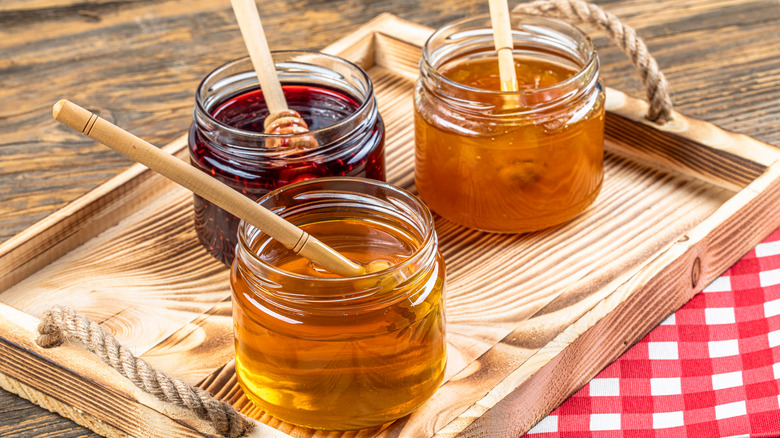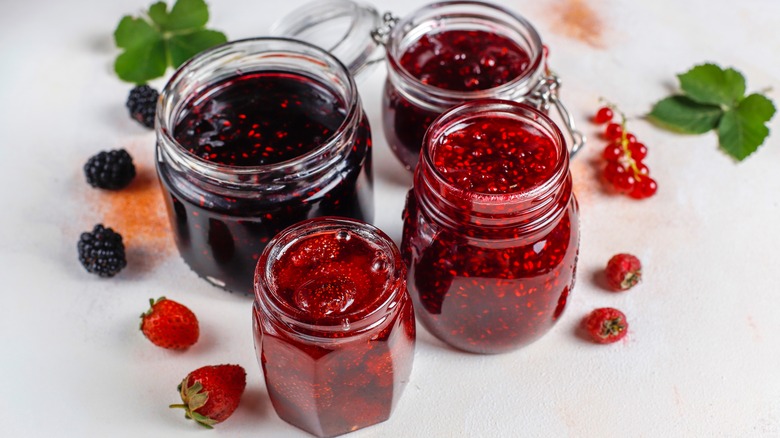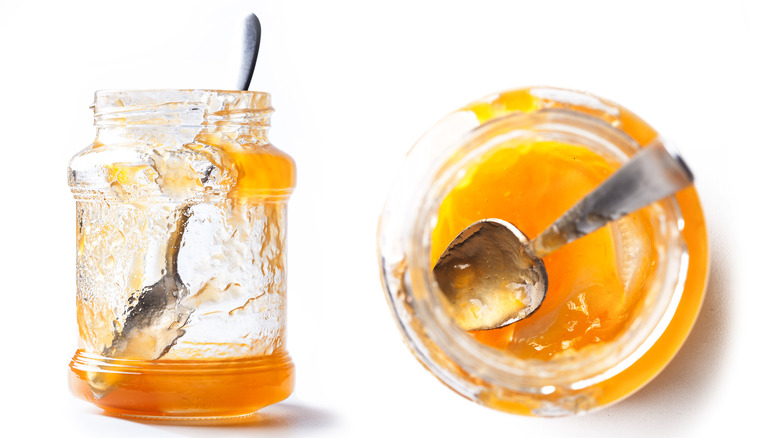How Long An Open Jar Of Jelly Will Last In Your Fridge
Jelly is a kitchen staple that so many people rely on to make sandwiches, cookies, cakes, and even meat-based dishes. Take a look at the ingredients of most jelly jars, and it's a pretty simple list: fruit, pectin, some sort of sweetener, and some form of preservative (like citric acid or sodium citrate).
The art of preserving fruit to make jams, jellies, and marmalades (along with refrigeration) keeps our fruit spreads safe and edible for much longer than fresh fruit lasts. Even so, if you've ever dipped into a jar and been met with spoilage, it can be slightly heartbreaking to have to toss that batch of your favorite spread.
There are differences between jellies, jams, and marmalades. Marmalades, usually from the citrus family, tend to use the peel or rind in addition to the fruit. Jellies are usually smoother, and jams are a bit chunkier, both using the fruit only — no peel or rinds. But none of this changes the process by which these fruit spreads are created or their shelf-life. Once opened and refrigerated, jellies should be used within six months (per the U.S. Department of Agriculture).
Spreadable fruit storage tips
You may ponder how long it's been open in your fridge, but when it's gone, there are obvious signs. Sometimes there's an odor similar to a fermented smell, or you can see spoilage right away. Do not scrape off the mold in hopes of using some of the jar's contents — the spores may have penetrated well beyond what you can see (via the USDA).
A great tool to use in your kitchen isn't the newest gadget. It's a permanent marker, enabling you to write down the date you opened the jar on the label or top of the jar. You can also jot it down on a calendar to avoid confusion later.
There are ways you can improve the duration of your jelly's life. Start by storing unopened jars in a cool, dark place to help them last longer. Once you've opened them and are storing your goods in the refrigerator, make sure you tighten the jar top to prevent the contents from oxidizing and losing color (especially low- or no-sugar varieties). Your fridge temp should be at 40 degrees Fahrenheit or lower. Don't leave the jar out on the counter when you're using it; instead, take out the amount you need and put the jar back into the fridge quickly.
Creative uses for jelly jars
If you are like many others, you'll use up that jam long before you have to consider the expiration date. And once that jar is just about empty, scrape the sides and the bottom of the jar to release the remainder of the jelly goodness to make a delicious cocktail shaker or use it to make your own fruity iced tea. You can even help your breakfast meal prep by using the jelly jar for overnight Matcha oats instead of your standard mason jar or bowl.
Washed glass jars can also be reused in the kitchen to store leftovers, dry goods like beans, and baking supplies like sugar or flour. You can keep the jar out near the stove to hold the utensils you'll need to cook with that day. There are a million ways to reuse these little glass beauties beyond the kitchen — you can even turn them into candle holders or a vase for fresh flowers. Before you toss or recycle that jar, think of a way to repurpose it. Empty jars and their tops can be used throughout the house and beyond.



